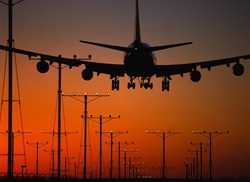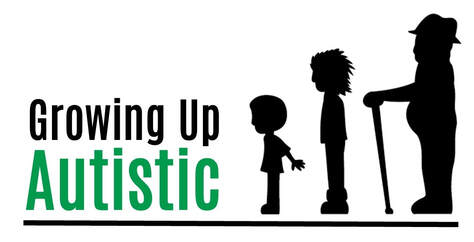
By Patty Pacelli
Trevor is flying home from college this weekend, and it will be his first time flying by himself. As his mom, I'm not too worried about him, because he has flown at least once a year during his life, but never alone. I wanted to write some tips about flying alone to help others who might be flying by themselves this season, with or without autism.
Preparation: If you are packing and preparing on your own, first decide whether to carry on your bag, or whether to check a bag. Anything you carry on cannot have liquids packed in it, and must fit in the overhead bins. Wheeled luggage is the best choice because you might have to walk a long way, and don't want to worry about a duffel getting too heavy or awkward. Any liquids and gels carried on must be in a quart size Ziploc bag and be 3 ounces or less each. Pack these in a backpack, tote bag or purse so they are easily accessible for Security. You are only allowed to carry on one small suitcase (for the overhead bins) and one other backpack or tote to put under the seat in front of you. Put your name, e-mail address and phone number on all your bags.
If your airline allows, you can check in on your computer, 24 hours in advance, and print your boarding pass. This is a good idea and will save you a step at the airport. Checking In: Whether someone is dropping you off, or you are taking a taxi or public transportation, enter the airport near your airline. There should be signs above the curb/sidewalk area with the airline names, i.e., Southwest, USAir, etc. Once inside, take a moment to look at your surroundings. There will be a lot of sights and sounds, so don't feel pressured or in a hurry. By the way, try to get to the airport extra early--2 hours or more before your flight time--so you don't have to hurry. If you have printed your boarding pass ahead of time, and not checking a bag, check the overhead monitors that list all the flights. Look for the city you are flying to and it will list the gate and departure time. This is where you will find out if your flight is delayed or on time. If you have not checked in at home, look for the check-in counters for your airline, which should be nearby if you entered at your airline's overhead sign. There will be kiosks and/or airline agents behind counters, and a waiting line, depending on how busy the airport is. Get in line and start getting your credit card or "locator number" ready. At the kiosk, you will swipe your credit card or type in your number and follow the instructions on the monitor to check yourself in. Again, take your time and read everything carefully. There are airline employees behind the counter to help if you have questions. This is where you will get your boarding pass, which will have your seat number, boarding group and gate number, and you will need it to get onto the plane. If you are checking a bag, you will do that in the same location, or possibly a nearby separate location. When your bag is checked, the agent will give you a small claim ticket. Save this in case there is any problem identifying or getting your bag when you get to your destination. Security: On your way to your gate, you will go through a Security Checkpoint. There might be different types of lines, such as ones for experienced travelers, travelers with children, or other categories. Choose the one you feel comfortable with. There is no requirement to choose a specific line. While waiting in line, get your boarding pass and driver's license or i.d., ready to show. The first step will be to show both of these to a security agent at a podium. As soon as you have shown them, you can put them safely away in your wallet and carry-ons so they don't get lost. At this point, stop, take a breath, and remember you don't have to hurry. Remember, it's always ok to let others go ahead of you if they are in a hurry. Your flight is still probably over an hour away, so you have plenty of time. Next, take off your belt, and shoes, empty your pockets of any change, cell phone or metals, and put them into a plastic bin that will go on the belt. Take your Ziploc bag of liquids out and put it in the bin. If you have a laptop computer, take it out of its case and put it in a bin. Use as many bins as you need to hold everything. Put your rolling bag or duffel, backpack or tote bag directly on the belt and make sure it is pushed onto the moving part that goes through the screening section. Once everything is on the belt, wait at the entrance to the body screening area for someone to motion you to walk through. You will either walk through it or stop and put your arms over your head to be screened. After you have walked through, an agent may ask you to stop and they might ask you a question, have you wait somewhere, or check something else on your body. Try to pay attention to the security agents so you will notice if they ask you anything. After you have walked through Security, gather your belongings out of your bins and get your bags off of the belt. Be extra careful that you don't leave anything. There is usually an area with chairs where you can put on your belt and shoes and get everything ready to take with you to the gate. Now you can walk to your gate and wait for your flight to leave. Check the time and if you'd like, check again for overhead monitors to see if your flight is still on time. Depending on how much time you have, you can go directly to your gate, or stop at the restroom, have a snack, or look in some of the shops. Your boarding pass will give a "boarding time" so make sure you are at your gate a little before that. Boarding: While you're at the gate, keep listening for instructions about when your group should board. There is a counter with your city and departure time and an agent in case you have questions. When you board, you will give the agent your boarding pass as you get on the plane. He will either scan it and give it back to you (if you have an assigned seat) or keep it and you will sit wherever you'd like (Southwest Airlines). As you are finding your seat, look for overhead space if you need it. You can use any space, as close to your seat as possible.
Once you are seated, listen to any instructions from the flight crew and enjoy your flight! When you land, be careful about leaving anything behind. Get your bag from the overhead compartment and exit the plane. When you land, look for signs that say "Baggage Claim." That is where you will get your bags if you checked them, and will meet anyone who came to pick you up from the airport.
Remember, there might be things that are unexpected, like delayed flights, longer flights, being stuck sitting on the plane at the gate, spills, sitting next to difficult people, and more. There are always people who can and will help you or answer questions, and if you prepare and plan ahead, you won't put yourself in a position to be stressed or in a hurry. Have a nice flight!
2 Comments
12/9/2013 06:37:27 am
When flying I try to rely on the "Meet and Assist". You often have to push hard to get it however it can be arranged prior to boarding the aircraft when you purchase a ticket, especially when you go overseas. The Meet and Assist allows assistance with boarding and exiting the aircraft, and early boarding can help prior to other passengers boarding. I find the take off can be a bit difficult at times as well as landing. Turbulence can also be another problem.
Reply
Lynne Bookstaber
12/9/2013 07:50:39 am
Great tips.Perhaps practicing at home before the trip might help prepare first timers with or without Autism.Have a wonderful trip and holiday season .
Reply
Leave a Reply. |
Inspiration for Life with AutismThis blog has a variety of articles about people living life with autism, and topics and ideas that can help in the journey. Guest bloggers are welcome. Inspired by Trevor, a young adult film critic, photographer and college graduate on the autism spectrum. Categories
All
Archives
July 2024
|
Proudly powered by Weebly

 RSS Feed
RSS Feed